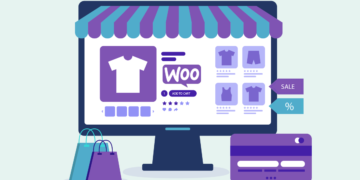
Beginning to sell online has become more accessible than ever before. All you need to take your business online is the right strategies, tools, and a stunning eCommerce store that captures the attention of your audience. In this comprehensive guide, we will walk you through the essential steps to create an eCommerce store that shines. From conceptualizing your brand to optimizing user experience, we’ve got you covered. So, let’s dive in!
7 Essential Steps To Create A Stunning E-commerce Store
1. Defining Your eCommerce Vision
Before diving into the technical aspects of creating your eCommerce store, it’s crucial to establish a strong foundation for your business. Defining your eCommerce vision involves understanding what sets your brand apart and who your target audience is.
- Crafting a Unique Selling Proposition (USP)
Your Unique Selling Proposition (USP) is what differentiates your eCommerce store from the competition. It’s the “wow” factor that makes customers choose you over others. Consider these tips for crafting an impactful USP:
- Highlight the benefits and value your products offer.
- Address pain points or challenges your target audience faces.
- Communicate your brand’s mission, values, and story.
- Identifying Your Target Audience
Understanding your target audience is essential for tailoring your eCommerce store to their preferences and needs. Use these strategies to identify your ideal customers:
- Conduct market research to gather demographic and psychographic data.
- Create buyer personas to visualize and empathize with your audience.
- Analyze competitors’ customer bases for insights.
- Choosing the Right Product Range
Selecting the right products is a fundamental aspect of eCommerce success. Consider these factors when curating your product range:
- Focus on products that align with your brand and USP.
- Offer a variety of products to cater to different customer preferences.
- Ensure your products have demand and solve specific problems.
- Establishing Clear Business Goals
Setting clear and achievable business goals helps you stay on track and measure your eCommerce store’s success. Keep these points in mind:
- Define specific, measurable, achievable, relevant, and time-bound (SMART) goals.
- Consider short-term and long-term objectives, such as sales targets and customer acquisition rates.
- Regularly review and adjust your goals based on performance.
2. Selecting the Ideal eCommerce Platform
Choosing the right eCommerce platform lays the groundwork for your online store’s functionality and user experience. An expert e-commerce development company helps in choosing the right platform and creating a visually appealing store that brings in customers. With numerous options available, here’s how they help you make the right choice:
- Exploring Different Platforms
There are various eCommerce platforms to choose from, each offering different features and benefits. Some popular options include:
- Shopify: Known for its user-friendly interface and extensive app store.
- WooCommerce: A customizable plugin for WordPress websites.
- Magento: Offers advanced customization and scalability for larger businesses.
- BigCommerce: Focuses on growth-oriented features and flexibility.
- Evaluating Features and Customization Options
Consider the features offered by each platform and how they align with your business needs:
- Payment gateways: Ensure the platform supports secure and diverse payment options.
- Customization: Look for themes and templates that match your brand’s aesthetics.
- Scalability: Choose a platform that can accommodate your business’s growth.
- Considering User-Friendliness and Scalability
Opt for a platform that balances ease of use with future scalability:
- Beginners might prefer user-friendly platforms like Shopify or WooCommerce.
- Growing businesses should opt for platforms like Magento or BigCommerce for scalability.
- Integrating Payment Gateways and Security Measures
Secure payment gateways are essential for instilling trust in your customers:
- Choose payment gateways that align with your target audience’s preferences.
- Implement SSL certificates and other security measures to protect customer data.
3. Designing Your eCommerce Storefront
The design of your eCommerce storefront plays a pivotal role in attracting and retaining customers. A visually appealing and user-friendly layout enhances the overall shopping experience:
- Implementing an Eye-Catching Layout
A clean and organized layout helps customers navigate your online store with ease:
- Use a simple and intuitive menu structure.
- Prioritize high-quality images and visuals that resonate with your brand.
- Prioritizing Mobile Responsiveness
A significant portion of online shoppers uses mobile devices. Ensure your eCommerce store is optimized for mobile:
- Choose a responsive theme or design to accommodate different screen sizes.
- Test the mobile shopping experience thoroughly to identify and fix any issues.
- Utilizing High-Quality Visuals and Graphics
Visual content plays a crucial role in capturing customers’ attention and conveying product details:
- Invest in professional product photography.
- Use high-resolution images and, if possible, offer 360-degree product views.
- Streamlining Navigation and User Flow
Smooth navigation enhances the user experience and encourages customers to explore more:
- Use clear and concise labels for categories and menu items.
- Implement a search bar with auto-suggestions for easy product discovery.
4. Curating Compelling Product Pages
Your product pages are where the magic happens – where visitors decide whether to make a purchase. Craft compelling product pages to entice and convert potential customers:
- Crafting Captivating Product Descriptions
Well-written product descriptions provide essential information while appealing to customers’ emotions:
- Use persuasive language to highlight benefits and features.
- Address potential objections or concerns in your descriptions.
- Showcasing Stunning Product Images and Videos
Visual content is essential for showcasing your products effectively:
- Include multiple high-resolution images from different angles.
- Consider adding product demonstration videos to give customers a better understanding.
- Displaying Customer Reviews and Testimonials
Social proof can significantly influence purchase decisions:
- Showcase genuine customer reviews and testimonials.
- Implement a rating system to quickly convey product popularity and quality.
- Implementing Urgency and Scarcity Elements
Create a sense of urgency to encourage immediate action:
- Use phrases like “Limited Time Offer” or “Only a Few Left.”
- Highlight discounts or special promotions to incentivize purchases.
5. Optimizing User Experience (UX)
A seamless and enjoyable user experience is critical for boosting conversions and retaining customers:
- Simplifying the Checkout Process
A complicated checkout process can lead to cart abandonment:
- Offer guest checkout options for customers who don’t want to create an account.
- Minimize the number of form fields and steps required to complete a purchase.
- Incorporating User-Friendly Search and Filters
Efficient search and filtering options improve product discovery:
- Implement a predictive search feature that suggests products as users type.
- Allow customers to filter products by attributes such as price, color, and size.
- Implementing Personalized Product Recommendations
Use data-driven algorithms to suggest relevant products:
- Display “Customers Who Bought This Also Bought” or “You Might Also Like” sections.
- Leverage browsing history and purchase behavior to make accurate recommendations.
- Minimizing Page Load Times for Better Performance
Slow-loading pages can frustrate customers and drive them away:
- Optimize images and other media files for web use.
- Use caching and content delivery networks (CDNs) to improve loading speeds.
6. Driving Traffic and Boosting Conversion
With your eCommerce store up and running, it’s time to attract visitors and convert them into customers:
- Harnessing the Power of Search Engine Optimization (SEO)
SEO helps your store rank higher in search engine results:
- Research and incorporate relevant keywords into product titles, descriptions, and meta tags.
- Optimize product images with descriptive alt text.
- Build high-quality backlinks through guest posts and collaborations.
- Leveraging Social Media Marketing Strategies
Utilize social media platforms to reach a broader audience:
- Share engaging and relevant content, including product showcases, behind-the-scenes peeks, and customer stories.
- Run targeted ad campaigns on platforms like Facebook, Instagram, and Pinterest.
- Running Effective Email Marketing Campaigns
Email marketing is a powerful tool for nurturing leads and driving sales:
- Build an email subscriber list through opt-in forms and incentives.
- Send personalized product recommendations and exclusive offers to subscribers.
- Exploring Pay-Per-Click (PPC) Advertising
PPC advertising allows you to place ads on search engines and other platforms:
Create compelling ad copy that resonates with your target audience.
Use highly relevant keywords and demographics to target your ads effectively.
7. Analyzing and Enhancing Performance
Continuous analysis and improvement are vital for the long-term success of your eCommerce store:
- Tracking Key Performance Indicators (KPIs)
Monitor essential metrics to measure your store’s performance:
- Track conversion rates, bounce rates, and average order values.
- Monitor website traffic, referral sources, and customer demographics.
- Conducting A/B Testing for Continuous Improvement
A/B testing helps you optimize various elements of your store:
- Test different call-to-action (CTA) buttons, colors, and placements.
- Experiment with product page layouts, pricing strategies, and shipping options.
- Gathering Customer Feedback and Implementing Changes
Feedback from customers can provide valuable insights for improvement:
- Use surveys, reviews, and customer support interactions to gather feedback.
- Implement changes based on customer suggestions to enhance their experience.
- Staying Updated with eCommerce Trends and Innovations
The eCommerce landscape is continually evolving, so staying informed is essential:
- Follow industry blogs, attend webinars, and engage in networking events.
- Embrace new technologies, such as virtual reality or augmented reality, to enhance the shopping experience.
Conclusion
Embarking on the journey of creating an eCommerce store that not only converts but thrives requires a strategic blend of creativity, innovation, and dedication. From defining your unique brand identity to optimizing user experience and implementing effective marketing strategies, every step plays a crucial role in your online business’s success.
Remember, building a successful eCommerce store is an ongoing process that demands continuous adaptation and improvement. Stay attuned to the ever-evolving trends in the eCommerce landscape, embrace new technologies, and actively seek feedback from your customers. By nurturing your store with the utmost care and commitment, you’ll be well on your way to igniting your online business and achieving remarkable results.
So, take the insights and knowledge gained from this guide, roll up your sleeves, and dive headfirst into the exciting world of eCommerce. With the right approach and a sprinkle of your unique brand magic, you’re poised to create an eCommerce store that not only converts visitors into loyal customers but thrives in the competitive digital realm.
Remember, your eCommerce journey is a story waiting to be written – and the pen is in your hands. Here’s to your future success as you set forth to create an eCommerce store that shines and prospers beyond your wildest dreams. Happy selling!























































